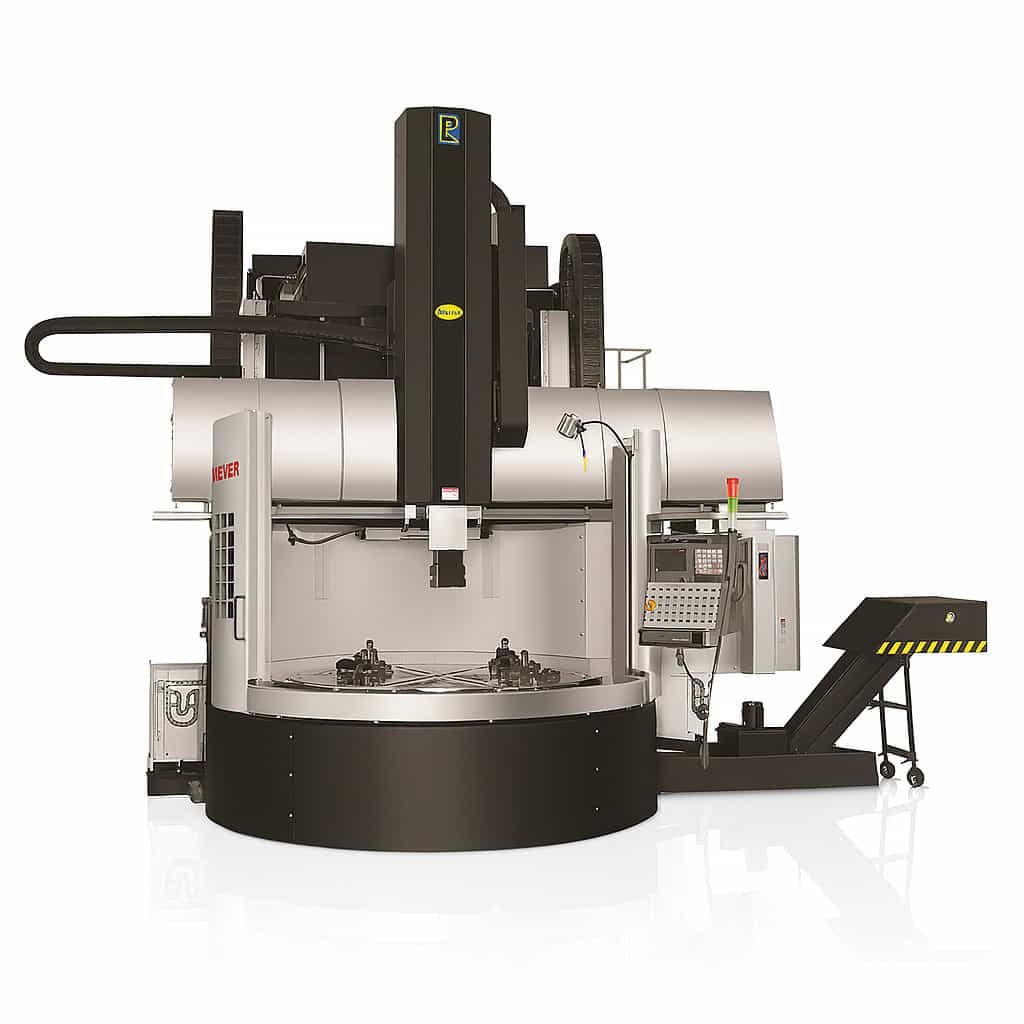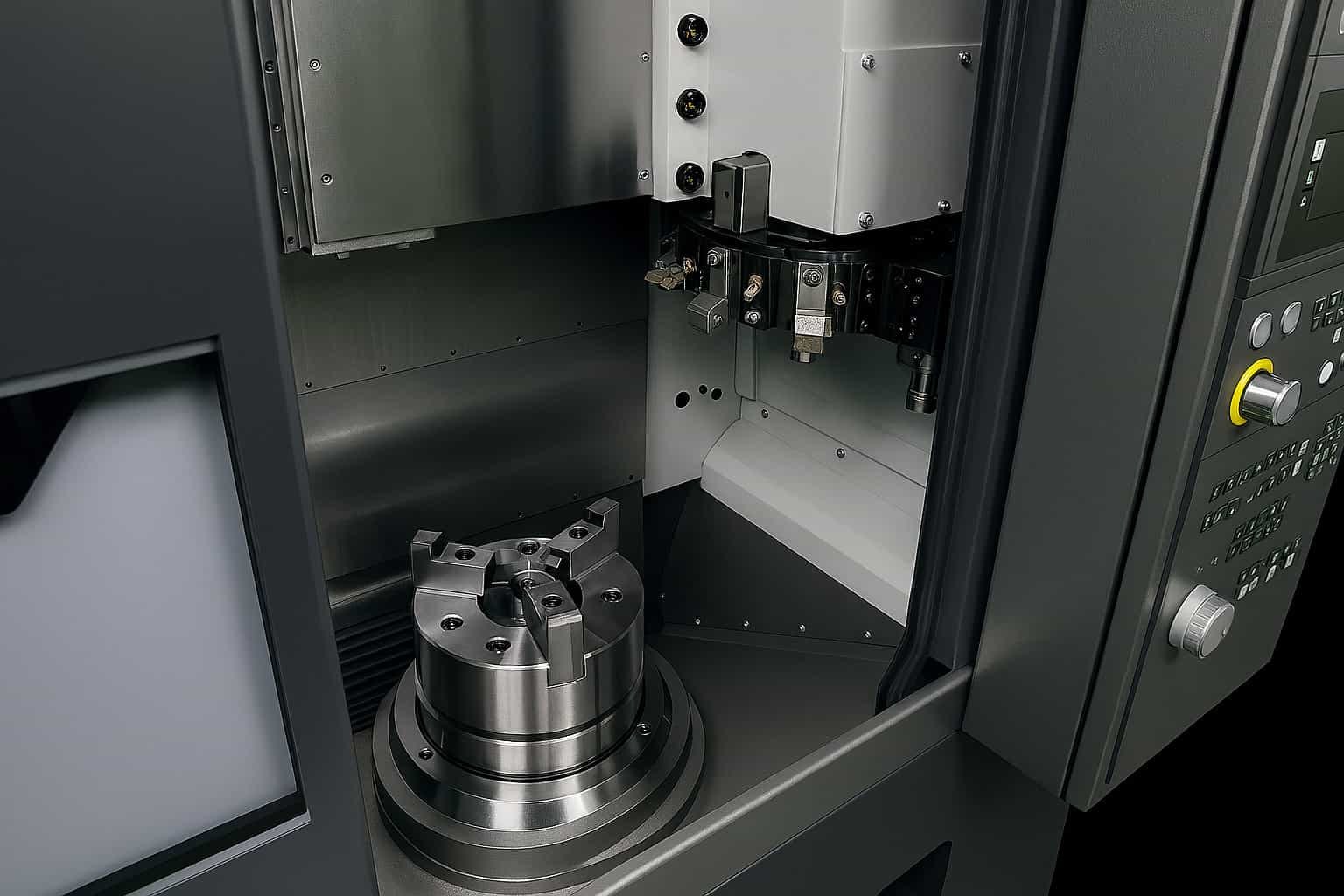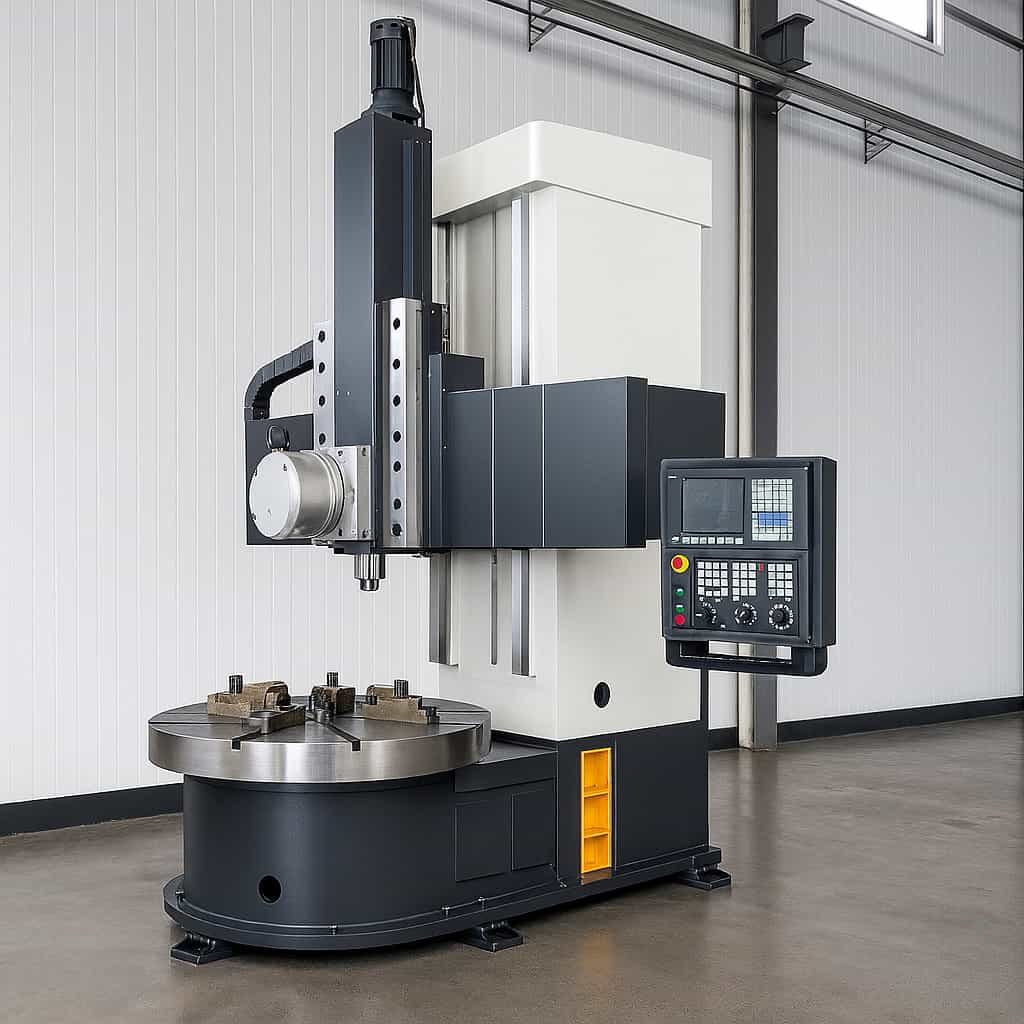A vertical CNC lathe is a computer-controlled machine with a vertically oriented spindle. It’s mainly used to turn large, heavy workpieces like brake discs, rings, or flanges.
Thanks to CNC technology, these machines can precisely cut and shape metal and other materials. They’re commonly used in industries such as automotive, aerospace, and heavy equipment manufacturing.
In this guide, you’ll learn what a vertical CNC lathe does, how it works, and where it’s most useful.
What is a Vertical CNC Lathe?
A Vertical CNC Lathe is a type of computer numerical control (CNC) machine that orients the spindle vertically to perform cutting, drilling, and shaping tasks on workpieces. It is commonly used for large, heavy, and awkwardly shaped objects.
Key Features
- Vertical Spindle Orientation: The spindle is aligned vertically, allowing for better handling of heavy and large workpieces.
- Computer Numerical Control: Uses pre-programmed software to control the movement and operation of the machine, ensuring high precision and repeatability.
- Workpiece Stability: The workpiece is clamped and rotated on a horizontal axis, providing enhanced stability during machining.
Applications
- Ideal for machining components for the aerospace, automotive, and heavy machinery industries.
- Frequently used for turning, boring, and facing large, cylindrical parts.
Advantages
- Precision: High accuracy due to CNC control.
- Efficiency: Faster setup and reduced manual intervention.
- Versatility: Suitable for both single-piece and mass production.
Vertical CNC Lathes are essential for industries requiring precision and efficiency in machining large and complex parts.
How Does a Vertical CNC Lathe Work?
A vertical CNC lathe operates by holding the workpiece vertically, allowing gravity to assist in stabilizing larger, heavier items. The machine uses a rotating spindle and cutting tool to shape the material, which is typically metal, into the desired form with high precision and efficiency.
Key Components and Operation:
- Vertical Orientation: The workpiece is mounted on a vertically-oriented spindle, facilitating better handling of heavy materials.
- CNC Control: The computerized numerical control (CNC) system directs the lathe’s movements, ensuring precise cuts as per programmed instructions.
- Cutting Tool: The cutting tool is positioned above the workpiece, moving in multiple axes to achieve the desired shape.
- Spindle Rotation: The spindle rotates the workpiece, while the cutting tool performs the machining processes.
Advantages:
- Stability: Ideal for machining large, heavy workpieces due to gravity-assisted stabilization.
- Precision: CNC technology ensures high-precision machining.
- Efficiency: Automated control increases productivity and reduces manual errors.
This setup is particularly beneficial in industries requiring high-precision and large-scale manufacturing, such as aerospace and automotive sectors.
Main Components of a Vertical CNC Lathe
A vertical CNC lathe primarily consists of the following main components: the bed, the spindle, the tool turret, the chuck, and the control panel. These components work together to ensure precise and efficient machining operations.

- Bed: The foundation that supports the entire machine, ensuring stability.
- Spindle: Rotates the workpiece at varying speeds, essential for cutting.
- Tool Turret: Houses multiple cutting tools, allowing for automatic tool changes.
- Chuck: Secures the workpiece in place during machining.
- Control Panel: User interface for programming and controlling the lathe’s operations.
Each component plays a critical role in the functionality of the vertical CNC lathe, enabling high precision and efficiency in manufacturing processes.
Common Applications of Vertical CNC Lathe
Vertical CNC lathes are predominantly used in the manufacturing industry for tasks that require high precision and efficiency. They are ideal for machining large, heavy, and asymmetrical workpieces such as engine components, aerospace parts, and heavy machinery.

Key Applications:
- Automotive Industry: Used for machining engine blocks, brake discs, and gearboxes.
- Aerospace Sector: Ideal for creating turbine blades, landing gear components, and structural parts.
- Heavy Machinery: Perfect for large equipment parts like hydraulic components and large bearings.
- Energy Production: Used in the creation of components for wind turbines and power generation equipment.
- Railway Industry: Machining of large train wheels and axles.
Benefits:
- Precision: Vertical CNC lathes offer high accuracy.
- Efficiency: Capable of handling large and heavy parts efficiently.
- Versatility: Suitable for a wide range of materials and complex shapes.
Vertical CNC lathes are essential for industries requiring precise and efficient machining of large components.
What are the Advantages and Limitations of a Vertical CNC Lathe?
A vertical CNC lathe offers several advantages, including enhanced stability, efficient chip removal, and better handling of large, heavy workpieces. However, it also has limitations such as higher initial costs and potential spatial constraints.
Advantages
- Stability: The vertical orientation provides a stable base, reducing vibrations and improving precision.
- Chip Removal: Gravity aids in efficient chip removal, minimizing tool wear.
- Handling Large Workpieces: Ideal for machining large and heavy parts, as the workpiece is securely clamped vertically.
Limitations
- Higher Initial Costs: Vertical CNC lathes are generally more expensive than horizontal ones.
- Spatial Constraints: They require more vertical space, which can be a limitation in smaller workshops.
- Accessibility: Loading and unloading large workpieces can be challenging and may require additional equipment.
Understanding these factors can help in making an informed decision when choosing a vertical CNC lathe for specific machining needs.
Vertical CNC vs Horizontal CNC Lathe
When comparing Vertical CNC machines to Horizontal CNC Lathes, the primary difference lies in the orientation of the spindle. Vertical CNC machines have a vertically oriented spindle, making them ideal for precision work on flat surfaces. Horizontal CNC Lathes, on the other hand, feature a horizontally oriented spindle, which is better for turning operations on cylindrical objects.
Key Differences:
- Spindle Orientation:
- Vertical CNC: Spindle is vertical.
- Horizontal CNC Lathe: Spindle is horizontal.
- Applications:
- Vertical CNC: Best for milling, drilling, and intricate detail work.
- Horizontal CNC Lathe: Suitable for heavy-duty cutting and turning cylindrical parts.
- Workpiece Handling:
- Vertical CNC: Easier to handle large, flat workpieces.
- Horizontal CNC Lathe: More efficient for long, cylindrical pieces.
Summary:
Vertical CNC machines excel in detailed, surface-oriented tasks, while Horizontal CNC Lathes are superior for robust, cylindrical machining operations. The choice between the two depends on the specific manufacturing needs and the type of workpieces involved.


